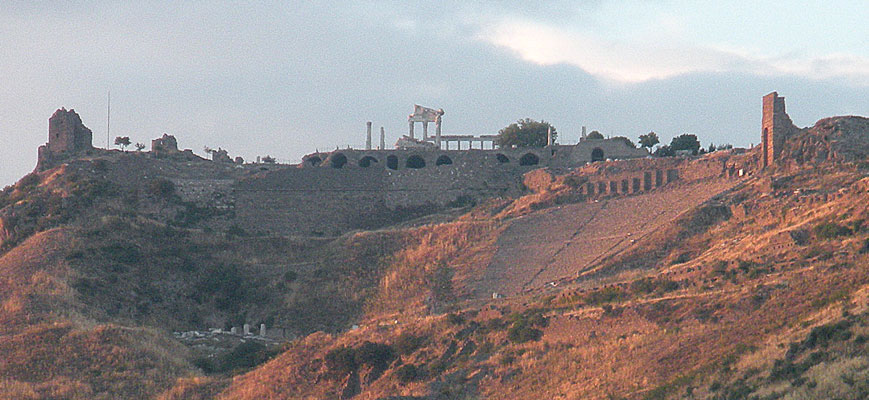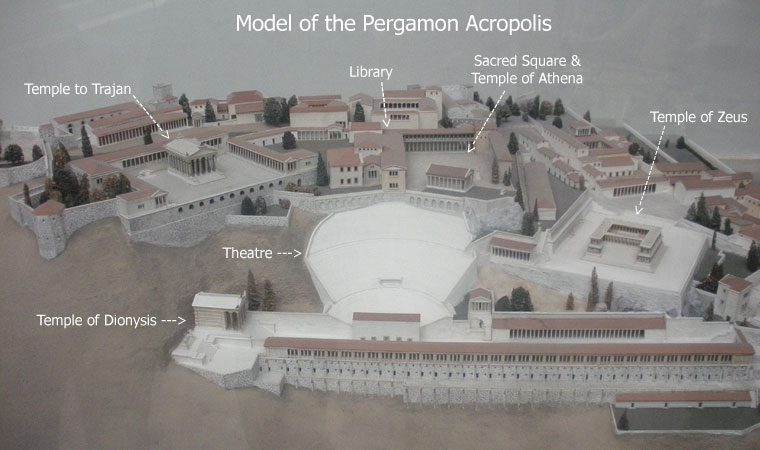Pergamon - Keystone of the Aegean Kingdoms
![]()
Our first view of Pergamon Acropolis, looking up from the city of Bergama. Following is a short history of Pergamon ending with a link to our picture gallery. Enjoy....

The fertile plain of the Bakirçay (Bergama River) provided rich lands for farming, so wandering people settled down here perhaps as early as 3000 BC. But it was the high plateau above the river that provided an obvious location for a castle fortress, an acropolis. Here, the Persians settled until the Greeks, under Alexander the Great, crossed the Dardanelles and won the war against the Persian King Denios, ending Persian rule in 334 BC.
Lysimakos, Alexander's successor, realized the strategic importance of Pergamon and fortified the plateau. He then left Phileteiros in charge of security along with his share of Alexander's treasure and went on to expand his kingdom, including the planning and construction of Ephesus.
Meanwhile, Phileteiros was secretly plotting behind his back with Syrian King Seleukos. A war ensued and Lysimakos was killed in battle; Phileteiros became king. His nephew, Eumenes I, succeeded him and ruled the people with wisdom and fairness. Next came Attalos I and then Eumenes II and his successors all of whom participated in geopolitics, siding with Rome against Syria, and enlarging the kingdom of Pergamon.
During this time the city became a cultural and scientific center and poets, artists, writers, historians and philosophers came to participate in discussions. Science, mathematics, architectural design and engineering flourished. The library was a center of knowledge, competing with Ephesus. The Temples to Zeus and to Athena were built, and many monuments and other great buildings adorned the Acropolis and the hillside below it.
When Attalos III died in 133 BC, he left the Kingdom of Pergamon to the Romans in his will! This caused great distress among the people and riots ensued throughout the kingdom until the Roman Consul arrived to establish order. As an important Roman base in Asia, Pergamon enjoyed great prosperity until Emperor Antonius arrived, packed up 200,000 books from the library and went off to Egypt to bestow them on Cleopatra. After this initial distress, the citizens of Pergamon enjoyed the favor of the Roman Emperors until 395AD when Emperor Constantine established the New Rome in Constantinople and the Byzantine Era brought peace and stability until the Ottoman Era began in 1306. By this time, there was no longer a need for a great Acropolis at Pergamon.
Back in the late 1800s, German archaeologists did extensive excavations of the Pergamon site. As part of the agreement with the Turkish government, they removed remnants of the Temple of Zeus and reassembled it in the Pergamon Museum in Berlin. We visited the museum and took pictures of the reassembled Temple and the friezes that adorned it and have included a few in our picture gallery of the Pergamon site.
The Museum's exhibition also includes a model of the entire Pergamon Acropolis as archaeologists think it looked in classical times. Following is our picture of this model with the location of some of the significant buildings noted. We hope it helps you understand what we saw as we visited the site.

Click here to come with us as we explore the Pergamon site....(opens in a new window)
Click here to return to our 'Summer 2010 - Turkey and More Time in Europe' page
![]()